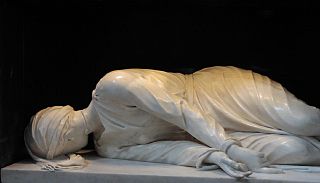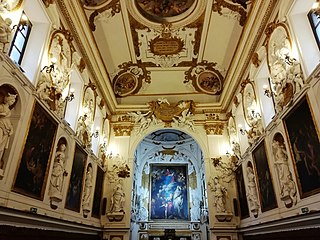
Stefano Maderno was one of the greatest Roman sculptors of the early 17th century.

Giacomo Serpotta was an Italian sculptor, active in a Rococo style and mainly working in stucco.

The Church of the Gesù, known also as the Saint Mary of Jesus or the Casa Professa, is a Baroque-style, Roman Catholic church established under the patronage of the Jesuit order, and located at Piazza Casa Professa 21 in Palermo, region of Sicily, Italy.

The Church of Saint Mary of Pity is a Baroque church of Palermo. It is located at the corner of Via Alloro and Via Torremuzza in the quarter of the Kalsa, within the historic centre of Palermo.

The Church of Saint Ursula of the Blacks is a Baroque-style, Roman Catholic church located in the central Via Maqueda #110, adjacent to the Palazzo Comitini, in the quarter of the Albergaria, within the historic centre of Palermo, Region of Sicily, Italy.

The Church of Saint Nympha is a Baroque-Mannerist church of Palermo. The facade rises on Via Maqueda, a block north of the central intersection known as the Quattro Canti, in the quarter of Seralcadi, within the historic centre of Palermo. The church belongs to the Camillians.

Porta Nuova is a monumental city gate of Palermo. It represents the entrance of the Cassaro from Corso Calatafimi and is located beside Palazzo dei Normanni, royal palace of Palermo. The gate was built to celebrate Charles V's conquest of Tunis (1535) and his visit to the capital of the Kingdom of Sicily.

The Church of Saint Matthew is a Baroque-style, Roman Catholic church of Palermo, region of Sicily, Italy. It is located in the main street of the city, the ancient Cassaro now Corso Vittorio Emanuele, in the quarter of the Loggia, about a block east of the Quattro Canti, within the historic centre of Palermo.

The Church of Saint Ignatius is a Baroque church of Palermo. It is located in the ancient neighborhood of the Olivella, in the quarter of the Loggia, within the historic centre of Palermo.

The Church of Saint Augustine is a Gothic church of Palermo. It is located near the market of the Capo, in the quarter of the Seralcadio, within the historic centre of Palermo. The church is also called Santa Rita, because of the devotion to this Augustinian saint.

The Church of Saint Teresa is a Baroque Roman Catholic church, located on Piazza della Kalsa, facing the Porta de Greci in the ancient quarter of the Kalsa of the city of Palermo, region of Sicily, Italy.

The Oratory of the Rosary of Saint Dominic is a Baroque oratory of Palermo. It is located near the Church of Saint Dominic, in the quarter of the Loggia, within the historic centre of Palermo.

The Palazzo Alliata di Villafranca is former aristocratic mansion, now converted into a museum, located just off Via Vittorio Emanuele facing the Piazza Bologni which opens two blocks west of the Quattro Canti intersection, in the ancient quarter of the Albergaria of the city of Palermo, region of Sicily, Italy.

Simone De Wobreck was a 16th-century Flemish painter, whose known works all come from his long period in Sicily.
The Diocesan Museum of Palermo is a museum of religious art in Palermo on Sicily, housed in a number of rooms in the Palazzo Arcivescovile opposite Palermo Cathedral.

Paolo Amato was an Italian Baroque and Rococo architect. He is also notable as author of the treatise La Nuova Pratica di Prospettiva, published in Palermo in 1732.

The Sicilian Renaissance forms part of the wider currents of scholarly and artistic development known as the Italian Renaissance. Spreading from the movement's main centres in Florence, Rome and Naples, when Renaissance Classicism reached Sicily it fused with influences from local late medieval and International Gothic art and Flemish painting to form a distinctive hybrid. The 1460s is usually identified as the start of the development of this distinctive Renaissance on the island, marked by the presence of Antonello da Messina, Francesco Laurana and Domenico Gagini, all three of whom influenced each other, sometimes basing their studios in the same city at the same time.
The Oratorio del Rosario di Santa Cita is a Baroque chapel or prayer room located in the quarter of the Castellamare within the historic center of Palermo, region of Sicily, Italy. The site is best known for the remarkable stucco tableaux scenes composed during 1687-1718 by Giacomo Serpotta.

The Oratorio dei Bianchi is a Baroque chapel or prayer room located on the Piazzeta dei Bianchi, about equidistant between the churches of Santa Maria dello Spasimo and Santa Teresa alla Kalsa in the quarter of the Kalsa, within the historic centre of Palermo, region of Sicily, Italy.

Santa Cita, reconsecrated in 1952 as San Mamiliano, is a baroque-style, Roman Catholic parish church located on Via Squarcialupo, 1, in the quarter of Castellammare of the city of Palermo, Sicily, Italy. The church and its artworks suffered heavily the bombardment during the Second World War, but it still contains original works and is attached to the Oratory of the Rosary of Santa Cita and less than a block north of the church of Santa Maria di Valverde.




















